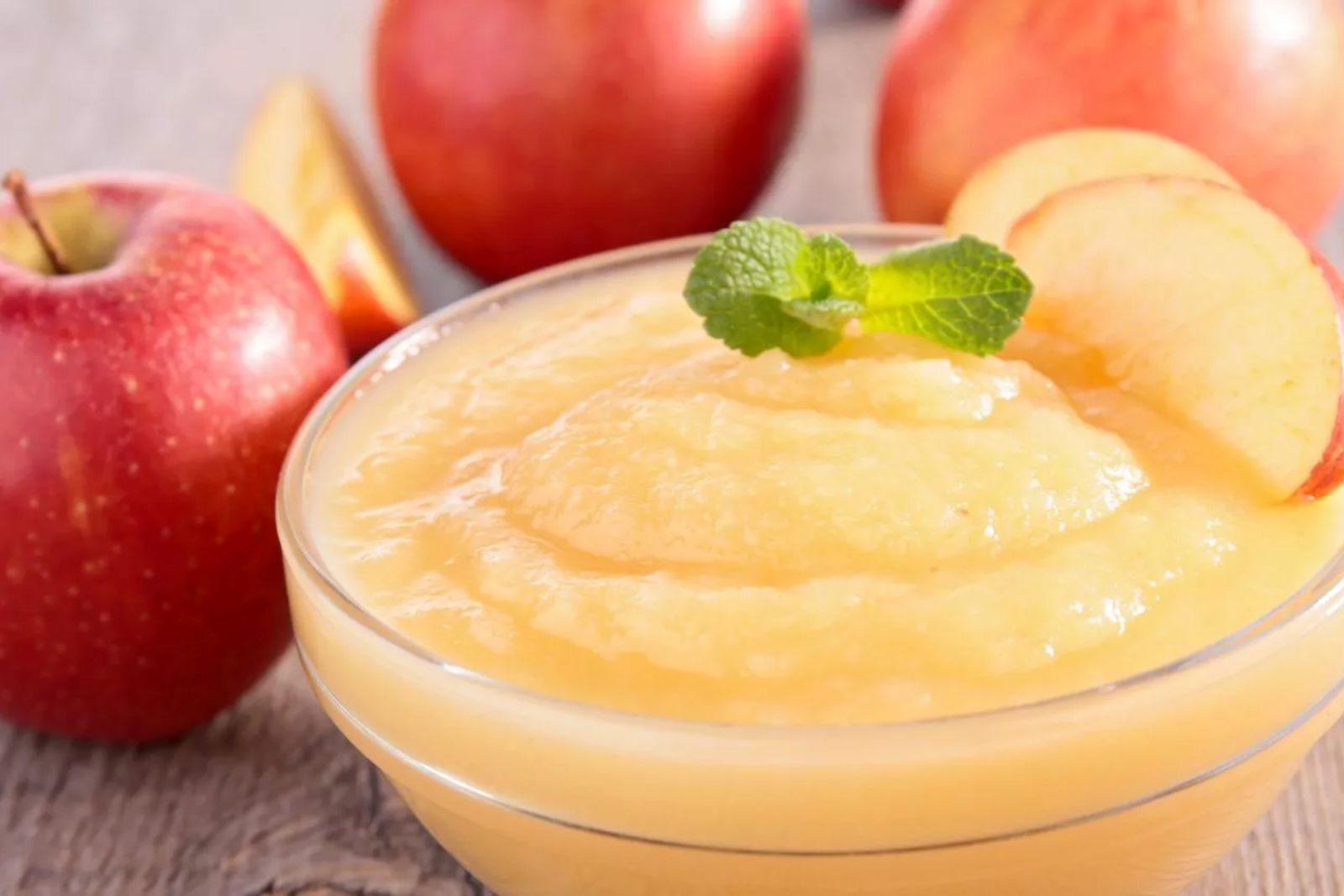
Apple sauce is a delightful condiment that adds a burst of sweetness and tanginess to a variety of dishes. Made by cooking apples with a touch of sugar and sometimes spices, apple sauce can be enjoyed on its own, paired with savory dishes, or used as an ingredient in baking and cooking. One of the great advantages of apple sauce is its ability to be frozen, allowing you to preserve the freshness and flavors of apples for an extended period of time. Freezing apple sauce not only provides a convenient way to have this delectable treat on hand whenever you desire but also allows you to take advantage of abundant apple harvests or prepare a large batch in advance. In this guide, we will explore the best methods for freezing apple sauce, ensuring that it retains its texture and taste even after being thawed.
Here are the simple steps for freezing apple sauce:
Step 1: Allow the apple sauce to cool down
After cooking or opening a jar of apple sauce, it is crucial to let it cool down completely before freezing. This step is essential to preserve the quality and flavor of the apple sauce during the freezing process.
When apple sauce is hot, it releases steam, which can create condensation inside the container if it is sealed while still warm. This condensation can lead to ice crystals forming, which can negatively impact the texture and taste of the sauce once it’s frozen and thawed. It may cause the sauce to become watery or develop an off-putting texture.
By allowing the apple sauce to cool down, you allow excess moisture to evaporate before sealing it for freezing. This helps maintain the original consistency and flavor of the sauce. Additionally, cooling the sauce also minimizes the risk of the container breaking or warping due to extreme temperature changes.
To cool the apple sauce, transfer it to a shallow container or a wide-mouthed bowl, which allows for faster and more even cooling. Stirring the sauce occasionally during the cooling process can help distribute the heat and expedite cooling. It is important to ensure that the apple sauce reaches room temperature before moving on to the next step.
Step 2: Choose appropriate containers
When freezing apple sauce, it is important to select suitable containers that are designed for freezer storage. There are several options available, including freezer-safe plastic containers, glass jars, or resealable freezer bags. The choice of the container depends on personal preference and convenience.
Freezer-safe plastic containers are a popular choice due to their durability and ability to withstand low temperatures. Look for containers that are specifically labeled as freezer-safe to ensure they won’t crack or become brittle when frozen. These containers come in various sizes, allowing you to portion the apple sauce according to your needs.
Glass jars are another option for freezing apple sauce. They provide an airtight seal and are safe for use in the freezer. It is important to choose jars specifically designed for freezing, as regular glass jars may break when exposed to extreme cold. Leave some headspace at the top of the jar to allow for expansion as the apple sauce freezes.
Resealable freezer bags are a convenient choice, especially if you prefer a space-saving option. Look for bags specifically labeled as freezer bags, as they are made from thicker, more durable materials to prevent freezer burn. Freezer bags also offer the advantage of being able to squeeze out excess air, minimizing the risk of freezer burn and preserving the quality of the apple sauce.
Regardless of the type of container you choose, ensure that it is clean and dry before filling it with apple sauce. Any residual dirt or moisture can affect the taste and quality of the sauce. Washing the containers with hot, soapy water and thoroughly dry them before use is recommended.
Remember to leave some headspace in the containers to allow for expansion as the apple sauce freezes. This precaution prevents the containers from bursting or cracking under the pressure of the expanding sauce.
Step 3: Portion the apple sauce
When freezing apple sauce, it is beneficial to portion it into smaller containers or freezer bags. This step offers several advantages, including the ability to defrost only the amount needed, faster and more even freezing, and proper allowance for expansion during the freezing process.
By dividing the apple sauce into smaller portions, you have the flexibility to thaw and use only the quantity you require, rather than having to thaw the entire batch. This is particularly useful when you want to enjoy the apple sauce in smaller servings or use it in recipes that call for specific amounts. It saves you from the inconvenience of defrosting more sauce than necessary and allows you to extend the overall shelf life of the remaining frozen portions.
Smaller portions of apple sauce also freeze more quickly and evenly compared to larger volumes. Freezing smaller quantities reduces the time required for the sauce to reach the desired frozen state, which helps maintain its flavor and texture. Additionally, smaller portions freeze more uniformly, preventing the formation of large ice crystals and ensuring consistent quality throughout.
When portioning the apple sauce into containers or bags, it is important to leave some headspace. This refers to the empty space at the top of the container or bag that allows for expansion as the apple sauce freezes. Liquids, including apple sauce, expand as they freeze, and leaving adequate headspace prevents the containers from bursting or cracking under pressure. It is recommended to leave about ½ inch (1.3 cm) of headspace to accommodate this expansion.
Portioning the apple sauce and leaving headspace for expansion not only safeguards the integrity of the containers but also helps maintain the quality of the sauce. It prevents leakage, maintains the proper texture, and ensures the flavors remain intact.
Step 4: Seal the containers
In order to preserve the quality of the apple sauce and protect it from freezer burn, it is essential to create an airtight seal when packaging it for freezing. The method of sealing depends on the type of containers being used, such as plastic containers, glass jars, or freezer bags.
If you are using plastic containers, ensure that the lids fit tightly onto the containers. Check for any cracks or gaps in the lids that could allow air to enter or moisture to escape. A secure seal prevents the apple sauce from being exposed to the dry air inside the freezer, which can cause freezer burn and affect the taste and texture of the sauce. Make sure to follow the manufacturer’s instructions for properly sealing the containers.
When using glass jars, leave about an inch of space at the top to allow for expansion during freezing. Screw the lids on firmly but not overly tight. This allows for the release of excess air and prevents pressure build-up that could cause the jars to crack. The airtight seal provided by the lids helps maintain the quality and flavor of the apple sauce.
If you prefer to use freezer bags, squeeze out as much excess air as possible before sealing them securely. Removing excess air minimizes the risk of freezer burn and helps maintain the freshness of the apple sauce. Press the bag to remove any air pockets and seal it tightly to create an airtight barrier.
Creating an airtight seal is crucial because it prevents the apple sauce from coming into contact with the cold, dry air in the freezer. Exposure to air can cause the sauce to lose moisture and develop freezer burn, which results in texture changes and degradation of flavor.
Step 5: Label and date the containers
Before you place the containers or bags of apple sauce in the freezer, it is crucial to label them with the date of freezing and a brief description of the contents. This step may seem simple, but it plays a significant role in maintaining organization and ensuring that you can easily identify and use the apple sauce in the future.
Labeling each container or bag with the date of freezing provides important information about the storage time. It helps you keep track of how long the apple sauce has been in the freezer, allowing you to prioritize consuming the older batches first. This is particularly important because frozen apple sauce, like any other frozen food, has a limited shelf life in terms of maintaining its quality and taste. By knowing the freezing date, you can ensure that you consume the sauce within the recommended time frame for the best flavor and texture.
Additionally, including a brief description of the contents on the label helps you quickly identify the apple sauce when retrieving it from the freezer. It eliminates the need to open multiple containers or bags to determine which one contains the apple sauce you desire. The description can be as simple as “Apple Sauce” or can specify any additional ingredients or variations, such as “Cinnamon Apple Sauce” or “Chunky Apple Sauce.” This ensures that you can easily locate and select the desired apple sauce without confusion or wastage.
Step 6: Freeze the apple sauce
Once you have properly sealed the containers or bags of apple sauce, it’s time to place them in the freezer for the actual freezing process. How you arrange and store them in the freezer can impact the quality and convenience of accessing the frozen apple sauce later on.
When initially freezing the apple sauce, it is recommended to arrange the sealed containers or bags in a single layer. This helps ensure that they freeze more quickly and evenly. By allowing sufficient space between the containers or bags, air can circulate around them, promoting faster freezing and maintaining consistent temperatures. It also reduces the risk of containers tipping or spilling, which could lead to a messy freezer.
Place the containers or bags on a flat surface, such as a freezer shelf or tray, to prevent them from toppling over and spilling their contents. This initial flat placement is particularly important if you’re using bags, as they may be more prone to leakage before they are fully frozen and sealed.
Once the apple sauce is frozen solid, you can stack the containers or bags to save space in the freezer. Stacking them is convenient when you have limited freezer space or want to organize multiple batches of apple sauce. However, ensure that the containers or bags are fully sealed and secure to prevent any accidental opening or cross-contamination.
Stacking the frozen containers or bags of apple sauce allows for more efficient use of freezer space, enabling you to store other items alongside them. It also makes it easier to locate and access the desired batch of apple sauce when you need it.
Other related questions
How long can apple sauce last in the freezer?
Apple sauce can typically last in the freezer for about 8 to 12 months. Properly stored, it maintains its quality and flavor during this period. However, for the best taste and texture, it is recommended to consume frozen apple sauce within 3 to 6 months.
How do you defrost apple sauce?
To defrost apple sauce, transfer the frozen container or bag to the refrigerator and let it thaw overnight. Alternatively, place the sealed container or bag in a bowl of cold water, ensuring it remains airtight, and change the water every 30 minutes until the sauce is thawed. It is important to never defrost apple sauce at room temperature or using hot water, as this can compromise its quality and safety.
Can you refreeze apple sauce?
It is generally not recommended to refreeze apple sauce once it has been thawed. Refreezing can negatively affect the quality, texture, and taste of the sauce. Additionally, the process of thawing and refreezing increases the risk of bacterial growth and potential foodborne illness. It is best to portion the apple sauce appropriately before freezing to ensure you can thaw and use only the amount needed at a time.
How do I know if the apple sauce has gone bad after being frozen?
To determine if frozen apple sauce has gone bad, check for signs of spoilage such as mold growth, off-putting odor, or a significant change in color or texture. If the sauce appears discolored, has a foul smell, or shows signs of mold, it is best to discard it. Additionally, taste a small amount to check for any unusual or unpleasant flavors. When in doubt, it is safer to err on the side of caution and discard the apple sauce if there are any doubts about its safety or quality.
Can I freeze homemade apple sauce?
Yes, homemade apple sauce can be frozen. Just ensure it is cooled down, properly stored in freezer-safe containers, and sealed tightly to maintain its quality during freezing.
Can I freeze store-bought apple sauce?
Absolutely! Store-bought apple sauce can be frozen as well. Follow the same steps of cooling, portioning, and sealing it in freezer-safe containers to preserve its freshness in the freezer.
Can I add spices or sweeteners to the apple sauce before freezing?
Yes, you can add spices or sweeteners to the apple sauce before freezing, but keep in mind that flavors may intensify during freezing. It’s a good idea to taste and adjust the seasoning before freezing to ensure it suits your preferences when thawed.
Can you freeze apple sauce in ice cube trays?
Yes, you can freeze applesauce in ice cube trays. Fill each compartment of the ice cube tray with the desired amount of applesauce, leaving a small space for expansion. Once frozen, transfer the applesauce cubes into a freezer-safe bag or container for long-term storage. This method allows for easy portioning and thawing of smaller amounts of applesauce as needed.








